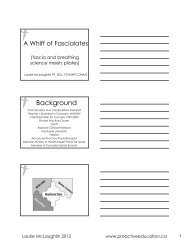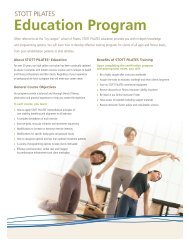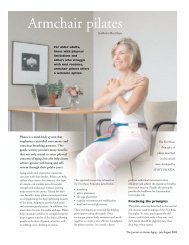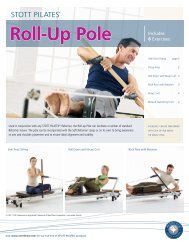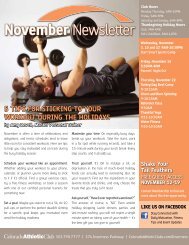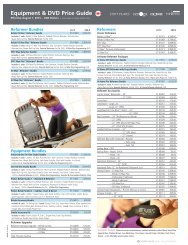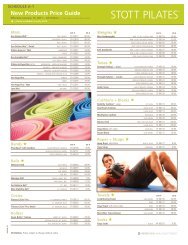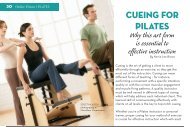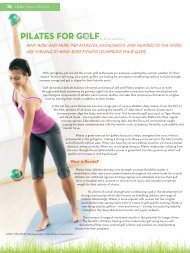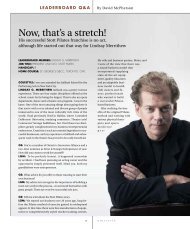Download STOTT PILATES® Five Basic Principles - Merrithew.com
Download STOTT PILATES® Five Basic Principles - Merrithew.com
Download STOTT PILATES® Five Basic Principles - Merrithew.com
Create successful ePaper yourself
Turn your PDF publications into a flip-book with our unique Google optimized e-Paper software.
2Pelvic Placement<br />
IT IS KEY TO EMPHASIZE stabilization of the<br />
pelvis and lumbar spine both statically and dynamically<br />
in all positions and throughout all movements. Two<br />
positions often referred to are neutral and imprint. In a<br />
neutral position, the natural anteriorly convex curve of<br />
the lumbar spine is present. When lying supine, the triangle<br />
formed by the ASIS and the symphysis pubis<br />
should be parallel to the mat. This is the most stable<br />
and optimal shock-absorbing position and a good place<br />
from which to promote efficient movement patterns.<br />
Neutral alignment should not be achieved by forcibly<br />
arching the back, but rather by allowing the weight of<br />
the sacrum to rest on the mat. While breathing, and<br />
with the transversus abdominis engaged, no strain<br />
should be felt through the spinal extensors in the<br />
lumbar area. If muscular tension occurs, shift the pelvis<br />
slightly toward a posterior placement. It is more<br />
important for the lumbar area not to strain than for the<br />
ASIS and symphysis pubis to lie in the same horizontal<br />
plane. For example, someone with large gluteals might<br />
actually create an exaggerated lordosis in the lumbar<br />
spine by trying to have the ASIS and symphysis pubis<br />
lie in the same plane.<br />
An imprinted position <strong>com</strong>bines a slight posterior<br />
pelvic tilt with slight lumbar flexion. The normal curve<br />
of the lumbar spine lengthens toward flexion by<br />
engaging the oblique abdominals to approximate the<br />
pelvis and the rib cage anteriorly. When supine, the<br />
pubic bone will be slightly higher than the ASIS. The<br />
pelvis is not so tilted that the sacrum curls off or loses<br />
contact with the mat.<br />
It is not necessary to press the lower back all the way<br />
into the mat or to tuck under by overusing the rectus<br />
abdominis and gluteal muscles respectively.<br />
3Rib Cage Placement<br />
THE ABDOMINAL WALL ATTACHES to the<br />
lower ribs. The abdominal muscles must often be<br />
recruited to maintain the rib cage, and indirectly, the<br />
thoracic spine, in proper alignment. Often the rib cage<br />
will tend to lift up in the supine position or deviate<br />
forward in a sitting position, extending the thoracic<br />
spine. Pay particular attention while inhaling or<br />
elevating the arms.<br />
When supine in neutral, maintain a sense of the<br />
weight of the ribs resting gently on the mat, neither<br />
lifting away nor pushing into the mat. Emphasize<br />
breathing three-dimensionally into the rib cage<br />
during inhalation.<br />
neutral<br />
imprint<br />
The degree of contact between the lumbar spine and the<br />
mat will differ from person to person.<br />
An imprinted position should be used to ensure stability<br />
of the pelvis and lumbar spine, if neutral alignment<br />
cannot be stabilized. When there is weakness in the<br />
obliques and other abdominals, placing them in this<br />
slightly shortened position can help maintain their<br />
engagement. This will often be useful when certain<br />
postural tendencies are present (for example, lordosis).<br />
When one or two feet are secure on the mat or other<br />
apparatus in a closed kinetic chain, the pelvis and<br />
lumbar spine are ideally neutral. When both feet are<br />
Allow the two sides of the rib cage to close toward each other during exhalation. Avoid overly depressing<br />
the rib cage, which will flex the thoracic spine, possibly extending the cervical spine and may deactivate the<br />
transversus abdominis.<br />
arms reach to ceiling<br />
off the floor in an open kinetic chain, the pelvis and<br />
lumbar spine should be in an imprinted position at first.<br />
Once enough strength has been developed through the<br />
abdominal muscles to achieve stability, a neutral<br />
position can be maintained in an open kinetic chain.<br />
EXPERIMENTING WITH<br />
PELVIC PLACEMENT<br />
Start supine, with pelvis and spine neutral. Knees<br />
flexed, feet abducted hip-distance apart on the mat.<br />
Arms long by sides, palms down.<br />
ROCKING PELVIS<br />
Rock pelvis through anterior and posterior tilts to<br />
explore the range of movement. Neutral position will<br />
be somewhere between the two.<br />
LEG SLIDES<br />
Test stability in a neutral position by sliding one foot<br />
along the mat, then drawing it back in. Limit the range<br />
of motion to where the lumbo-pelvic region can<br />
be stabilized.<br />
Inhale To slide foot away.<br />
Exhale To return.<br />
NEUTRAL TO IMPRINT<br />
Inhale Maintain a neutral alignment.<br />
Exhale Contract abdominals and imprint.<br />
Inhale Maintain an imprinted position.<br />
Exhale Return to neutral.<br />
The transversus abdominis remains engaged throughout<br />
while the obliques shorten during imprint, and lengthen<br />
during return to neutral. Try lifting one or two feet off<br />
the floor to test the stability of the imprint.<br />
starting position<br />
<strong>STOTT</strong> PILATES ® – the only full-service organization of its kind in the world, providing high-caliber Pilates e




